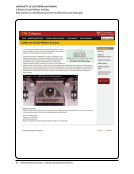102 · Representative Documents: Collection Descriptions and Policies
WASHINGTON UNIVERSITY IN ST. LOUIS
Documenting Ferguson. Project Explanation and Purpose
http://digital.wustl.edu/ferguson/DFP-Plan.pdf
Preserving Content
To ensure long term sustainability of content in Documenting Ferguson, contributed items will be ingested in
WUSTL’s Fedora Repository for preservation. An administrator will copy files from the Omeka server to Digital
Library Services servers and rename them with the contributor’s last name, first initial, and descriptive
information (for example, regesterm-manincrown-ggchurch.jpg). The metadata for the contributed item will be
exported from Omeka using dcmes-xml (Dublin Core) output format and the new filename will be entered in the
item’s exported metadata. Ingesting items in Fedora also facilitates eventually moving the Documenting
Ferguson collection from Omeka to Hydra.
Content Development
The promise of the Documenting Ferguson project is in successfully securing a diverse collection of content for the
project. The initial stages of content development will focus on obtaining and selecting content. As the repository grows
and our partnerships develop, we plan to implement content programming focused on user education and community
engagement.
Obtaining Content
Our suggested plan for securing content is a two-prong approach using a marketing strategy and collaborative
partnerships. The marketing strategy will build awareness about the project through promotional literature and
advertising. Building an awareness of DFP will spark interests and encourage participation through contributing
content. Efforts to obtain content will require the DFP to create presence at local community events. This will
also require assistance from our collaborative partners that might be sponsoring.
Targeted Opportunities to Obtain Content:
• Promotional literature
• Advertising in local media
• Recruit Wash U employees that are Ferguson residents to share promo materials
• Attend local events
• Contact with people directly involved in events (this may need to wait until we have more partnerships
and trust established)
• Collaborate with Divided Cities outreach
• Create opportunities for current contributors to talk about their work to create awareness
• Create a component/infrastructure of DFP which will acquire physical content of the Ferguson
Movement
Selecting Content
All content will adhere to guidelines set out in the Terms and Approval section. The review process for selecting
i.e. accepting submitted materials will be an open policy. Our aim is not to limit perspectives on the aftermath
of Ferguson. Some materials might seem tangentially related but because of the lens with which contributors
view the issues they might see their content as wholly relevant.
3
WASHINGTON UNIVERSITY IN ST. LOUIS
Documenting Ferguson. Project Explanation and Purpose
http://digital.wustl.edu/ferguson/DFP-Plan.pdf
Preserving Content
To ensure long term sustainability of content in Documenting Ferguson, contributed items will be ingested in
WUSTL’s Fedora Repository for preservation. An administrator will copy files from the Omeka server to Digital
Library Services servers and rename them with the contributor’s last name, first initial, and descriptive
information (for example, regesterm-manincrown-ggchurch.jpg). The metadata for the contributed item will be
exported from Omeka using dcmes-xml (Dublin Core) output format and the new filename will be entered in the
item’s exported metadata. Ingesting items in Fedora also facilitates eventually moving the Documenting
Ferguson collection from Omeka to Hydra.
Content Development
The promise of the Documenting Ferguson project is in successfully securing a diverse collection of content for the
project. The initial stages of content development will focus on obtaining and selecting content. As the repository grows
and our partnerships develop, we plan to implement content programming focused on user education and community
engagement.
Obtaining Content
Our suggested plan for securing content is a two-prong approach using a marketing strategy and collaborative
partnerships. The marketing strategy will build awareness about the project through promotional literature and
advertising. Building an awareness of DFP will spark interests and encourage participation through contributing
content. Efforts to obtain content will require the DFP to create presence at local community events. This will
also require assistance from our collaborative partners that might be sponsoring.
Targeted Opportunities to Obtain Content:
• Promotional literature
• Advertising in local media
• Recruit Wash U employees that are Ferguson residents to share promo materials
• Attend local events
• Contact with people directly involved in events (this may need to wait until we have more partnerships
and trust established)
• Collaborate with Divided Cities outreach
• Create opportunities for current contributors to talk about their work to create awareness
• Create a component/infrastructure of DFP which will acquire physical content of the Ferguson
Movement
Selecting Content
All content will adhere to guidelines set out in the Terms and Approval section. The review process for selecting
i.e. accepting submitted materials will be an open policy. Our aim is not to limit perspectives on the aftermath
of Ferguson. Some materials might seem tangentially related but because of the lens with which contributors
view the issues they might see their content as wholly relevant.
3
























































































































































































